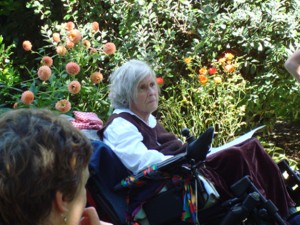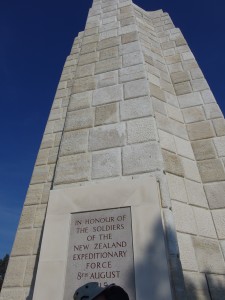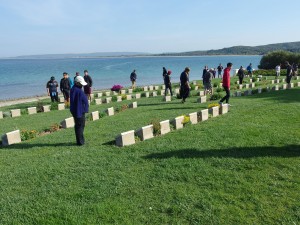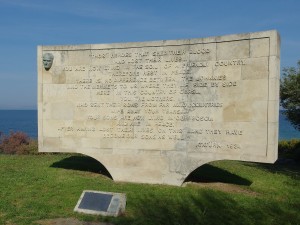Archive for the ‘death’ Category
A single knitting needle
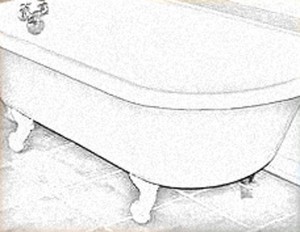 The significance of the knitting needle did not dawn on me at first. I found it under the bath tub, buried in a mound of dust balls, while I was cleaning the flat we has just moved into, in Windsor, England, in 1962.
The significance of the knitting needle did not dawn on me at first. I found it under the bath tub, buried in a mound of dust balls, while I was cleaning the flat we has just moved into, in Windsor, England, in 1962.
The flat was part of a semi-detached house dating from the 1870s. The bathroom could have been original. The floor was covered in black and white checkered linoleum, worn white in front of the chipped hand basin. Above the claw-foot tub was a rusty gas-fired contraption that roared to life when you turned on the faucet. The toilet was down the hall, in a more recent addition to the building.
That knitting needle haunted me, as gradually I came to realize it was probably the instrument of an attempted abortion. I longed to know the story of the woman who had pushed it through the crack between the tub rim and the wall. Did she survive?
The conservative New Zealand society in which I grew up had such deep silences around anything to do with sexuality that I was nineteen before I even encountered the word “abortion.” It was in a letter from my mother. “Look it up,” she wrote, her stock response to any question having to do with the body. Mum’s news was that a girl I knew in high school was dead: a move to the city, an affair with a married man, a botched back street abortion, septicemia, the police phoning her parents, saying contemptuously Come and get your kid.
I too have known the desperation of an unwanted pregnancy. I went into marriage in 1960 with what today would seem unbelievable ignorance about sex. The kind ladies at the Planned Parenthood clinic in Christchurch fitted me with a diaphragm and instructed me in how to use it. But the contraceptive methods of those days had a high failure rate. Within a month of the wedding I was pregnant. My new husband was furious with me for stymying his plans to go abroad and make his name in science. I was terrified of the alien life form taking over my body. I tried to recall from novels I’d read how female characters sought to make missed periods come. Scalding hot baths—I tried that. Long, long walks—tried that too, into the seedier parts of the city. If I were to find an abortionist, it would be here. But I had no idea how to find one, and no-one to ask. Besides, I didn’t want to die, like my high school friend.
In time my resistance eased. I was, after all, a respectably married woman. I began to look forward to having a baby. My husband and I postponed the date for our departure to England, and informed the shipping company that we would be traveling with an infant. When our daughter was stillborn, I was devastated, both by the loss, and by the thought that I was being punished for not wanting her in the first place. I buried my grief and guilt deep inside and got on with my life. It took me twenty-five years before I could speak about what had happened, and finally begin to mourn.
In California in the early 1970s I made the acquaintance of a lawyer who had filed an amicus curiae brief in Roe vs. Wade. Together we celebrated that important Supreme Court decision, which affirmed a woman’s right to control her own body. Today I am dismayed that so many people seem to have forgotten, or maybe never knew, what the options were for women when abortion was illegal. The decision to end a pregnancy is never easy. But I, for one, don’t want to go back to the days of the knitting needle hidden under the bathtub.
Going Dark
In 1966, my friend Diana Neutze developed multiple sclerosis (MS). She was not yet thirty years old.
I first met Diana about ten years before this, when we shared English Lit. classes as freshmen at Canterbury University in Christchurch, New Zealand. During school breaks we worked as kitchen hands at the same remote fishing camp. I was part of her wedding, and she of mine. We lived next-door to each other as young marrieds, and shared survival tips as penniless expatriate mothers of small children in London. Even after I moved to California and she returned to New Zealand, we stayed in touch as best we could.
For decades Diana’s illness came and went. She learned to live with it, devising ingenious stratagems for making sure she stayed mobile and independent. Whenever possible, she refused medications. All she had left, she said, was her mind, and her ability to find joy in music and the beauty of her garden. Painkillers took that clarity of mind from her, and this she could not allow. Right up until the end she was writing and publishing poetry. (I reviewed a recent book in these pages) I introduced her, via email, to a quadriplegic friend who got her started with voice recognition software. When she could no longer edit using one finger on a keyboard, or see to read, she dictated edits to a carer.
Diana and I traded poems and, as her body slowly but inexorably closed down, thoughts about death. She was in my mind when Gallery Bookshop in Mendocino invited local poets to respond to Wendell Berry’s poem “Going Dark” at a 2012 Winter Solstice event. I sent the poem to Diana, and included it in my new chapbook, Earthward. When I spoke to Diana via Skype in April 2013, three days before she died, she accepted my promise to dedicate Earthward, to her memory. At her request, my poem, “Going Dark,” was read at her funeral. Here it is:
Going Dark
To go in the dark with a light is to know the light.
To know the dark, go dark. Go without sight,
and find that the dark, too, blooms and sings,
and is traveled by dark feet and dark wings.
— Wendell Berry
My friend’s body is a brown leaf,
shriveled and curled inward.
Pain is a constant, yet
the fierce flame of her will
refuses surrender.
It’s not death’s darkness she resists
but the loss of a self transfixed
by what is beautiful:
a Bach air, the light
through her walnut tree.
This dark she speaks of
has no scent of earth,
no draft from unseen wings,
no sudden rustle in the undergrowth.
What can I say to her, and to myself,
this season of gathering in
our lives against the rainy dark,
against the ancient fear
that light will not return?
Just this: a dry leaf
fallen to ground disintegrates,
becomes the food that nourishes
all that sweetly blooms and sings.
My chapbook Earthward is available from Finishing Line Press. The direct link is: https://finishinglinepress.com/product_info.php?cPath=4&products_id=2129
Some of Diana Neutze’s poems can be read on her blog site, Living With Multiple Sclerosis.
Given Time
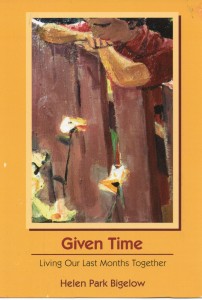 Given Time: Living Our Last Months Together by Helen Park Bigelow, which I’ve just finished reading, is an unflinching look at the emotional and physical landscape a care-giving spouse or partner must traverse in those last months before death. Helen’s husband Ed had a melanoma removed in 2005. The surgery seemed successful, and regular follow-up tests and scans at first came out clear. But three years later the melanoma returned and metastasized throughout his body.
Given Time: Living Our Last Months Together by Helen Park Bigelow, which I’ve just finished reading, is an unflinching look at the emotional and physical landscape a care-giving spouse or partner must traverse in those last months before death. Helen’s husband Ed had a melanoma removed in 2005. The surgery seemed successful, and regular follow-up tests and scans at first came out clear. But three years later the melanoma returned and metastasized throughout his body.
To offer a flavor of the book, I can’t do better than to quote the blurb by Fithian Press, the book’s publisher: “The book deals honestly with the process of dying, an ordeal shared by both of them. It also deals with the process of staying alive and in love until the ordeal is over… [Bigelow] writes with brutal honesty about her anger and grief over what has become of her husband and herself. The book isn’t a manual about how to take care of a dying man, but it makes the reader well aware of what a grueling job it is. “So this is it,” she writes. ‘This chemo routine is the rest of our lives together…and goddamn it, it’s going to be as good for both of us as I can make it.’ ”
Reading this book set me to thinking about my husband’s and my circle of friends. We’re all of an age where we’re facing mortality, both our own and our partners’. Physical infirmities creep up on us. Memories start to fail. The mechanisms of the heart become clogged. I know we’ll all do what we have to do, to the best of our abilities, when loved ones need our care, and that, if we are the ones whose lives are ending, we hope to have someone as caring as Helen to tend our passage. I’m grateful that services such as hospice are available. Most of all, I am inspired by Helen’s love of beauty to seek it out in my own life. Whether my time is counted in decades or years or even months, I want every day to be touched by grace.
At Gallipoli
The Anzac Day memory floats up from my childhood: gray dawn in a small New Zealand town, plod and shuffle of marching feet, old men in uniforms button-stretched across their chests. The oldest of the veterans lays a wreath at the foot of a cenotaph where names are inscribed: casualties of the First World War.
When the war started in 1914, New Zealand was a British colony of less than a million people. Eager to come to the aid of the mother country in her time of need, more than 100,000 men signed up, and well over half of these were killed or wounded. A place name that crops up often on the marble tablets of small New Zealand towns is Gallipoli, Turkey. Seeking to take Constantinople, Winston Churchill, who was then First Lord of the Admiralty, sent the Australia and New Zealand Expeditionary Force (the ANZACs) to storm the Gallipoli Peninsula, which overlooks the Dardanelles, a channel connecting the Aegean Sea to the Sea of Marmara and the Black Sea. Writing in Slate, journalist Andrew Curry comments: “Though Gallipoli was a small conflict compared with landmark battles of the first world war like the Somme, the battle for the narrow peninsula contains the story of the war in microcosm: the fatal bravado, the futile fighting, the error-prone assumptions made by politicians and generals, and the killing fields that decimated a generation of young men.”
At dawn on April 25, 1915, the ANZACs landed at a small cove surrounded by steep cliffs. They met stiff resistance from Turkish troops. For nearly nine months the two sides fought and died, until finally the ANZACs withdrew. The website for the New Zealand Ministry for Culture and Heritage comments: “It may have led to a military defeat, but for many New Zealanders then and since, the Gallipoli landings meant the beginning of something else – a feeling that New Zealand had a role as a distinct nation, even as it fought on the other side of the world in the name of the British Empire.”
The rugged landscape of the peninsula is now a Turkish national park, filled with cemeteries and monuments to the dead of both sides. I was there last week, almost ninety-nine years after that tragic venture. At every memorial site, huge semi-circles of temporary bleachers were being set up for the Anzac Day ceremonies, which will be attended on April 25 by tens of thousands of Turks, Australians and New Zealanders.
With us also at Gallipoli last week was a group of New Zealand high school students. We had met them the previous day in Troy where, in the shadow of a modern Trojan Horse sculpture, and with “ancient Greek” costumes rented from a nearby stall, they were having an exuberantly good time re-enacting battle scenes from Homer’s Iliad.
This day at Anzac Cove the mood was markedly different. With solemn steps the students inspected the graves, where the ages of the dead were little different from their own: seventeen, eighteen, twenty-four. One young man passed out red lapel poppies to visitors, including our American tour group. We watched as one by one the students approached the cenotaph, placed their poppy at its base, and stood a moment with bowed head.
A New Zealander by birth, I have not lived in my home country for fifty years. Nevertheless, that day of pilgrimage I carried with me a small New Zealand flag. Following the students’ example, I attached my poppy to the flag and placed them both in the drift of red poppy emblems that lay like fallen petals at the cenotaph’s base. I thought of the stories from Gallipoli of Turkish and ANZAC soldiers who bombed each other by day and in the evening shared cigarettes and rations and helped tend each other’s wounded. I thought of the kindness of our Turkish tour guide who reorganized the tour schedule so that my husband and I could visit the New Zealand memorial site. I thought of the words of Mustafa Kemal Ataturk, who led the Turkish troops, and later went on to become the founder of the Turkish Republic. They are engraved in stone at Gallipoli:
Those heroes that shed their blood
And lost their lives.
You are now lying in the soil of a friendly country.
Therefore, rest in peace.
There is no difference between the Johnnies
And the Mehmets to us where they lie side by side
Here in this country of ours,
You, the mothers,
Who sent their sons from far away countries
Wipe away your tears,
Your sons are now lying in our bosom
And are in peace
After having lost their lives on this land they have
Become our sons as well.
Circles
A beautiful image from an old friend, who recently scattered the ashes of her late husband:
“… as I threw the handfuls of ash into the water—they made circles ever widening which explains why I dislike the term closure— it is not one circle, of life with a beginning and ending, but one circle making many concentric circles which widen as a life enlarges, and sometimes the circles intersect as one life touches many and adds meaning to other lives forever…. ”
In Memoriam: Hillary the Cat
Our good tabby-cat Hillary died this week, at the ripe old age of twenty. The house feels strangely empty. We miss his quiet, gentlemanly presence. He was a devoted friend, especially to my husband Tony. Evenings he would lie in Tony’s arms, paw stretched out to touch his chest, like a baby.
When he was younger, the two of them would sometimes take a walk together around our meadow. Hillary would bounce back, tail fluffed, excited at having ventured into this scary place so close to the forest.
The two of them also had a daily ritual. Until he was too frail to go outdoors, Hillary would walk to the mailbox with Tony every morning to collect the newspaper. I loved to stand at the window and watch. Tail aloft like a slender questionmark, he would stroll at Tony’s side to a point about halfway down the drive, where he would wait, invisible to any passing dog. On their way back to the house his pace quickened; once inside he knew he would receive a kitty treat.
From the moment he curled into the palm of my hand as a tiny kitten, I knew he was a mellow cat. Mellow he remained, right up to the end. We buried him in the orchard, where the white petals of plum blossom will fall on his grave.
